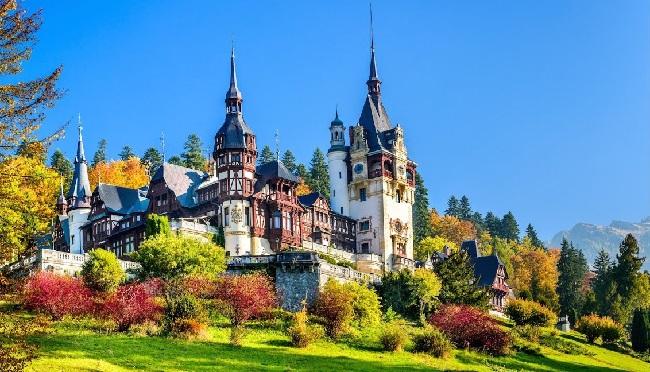Romania, a country where history and folklore intertwine, offers a diverse array of attractions, from medieval castles and fortified churches to wild forests and mountain landscapes.
Discover the top 10 destinations that draw visitors to explore the rich cultural tapestry of Romania.

Top 10 Most Visited Places in Romania
1. Bran Castle
Overview
Often associated with the Dracula legend, Bran Castle sits atop a cliff in Transylvania and is one of Romania’s most iconic landmarks.
Why Visit?
Explore the castle’s historic rooms, learn about the Dracula legend and the real-life Vlad the Impaler, and enjoy the panoramic views of the surrounding mountains.
2. Peleș Castle
Overview
Peleș Castle is a masterpiece of Neo-Renaissance architecture, once the summer residence of Romanian royalty and now a stunning museum.
Why Visit?
Admire the castle’s opulent interior, its extensive collection of art and armor, and the beautifully landscaped gardens.
3. The Danube Delta
Overview
The Danube Delta, a UNESCO World Heritage site, is the second-largest river delta in Europe, renowned for its rich biodiversity and natural beauty.
Why Visit?
Enjoy bird watching, fishing, and boating through the network of marshes and lakes, and savor the fresh, locally caught fish.
4. The Painted Monasteries of Bucovina
Overview
The Painted Monasteries, with their vibrant exterior frescoes depicting biblical scenes, are unique architectural treasures of northeastern Romania.
Why Visit?
Witness the well-preserved frescoes at Voroneț, known as the ‘Sistine Chapel of the East,’ and other monasteries like Sucevița and Moldovița.
5. Sibiu
Overview
Sibiu, with its Germanic architecture, is one of the most important cultural centers of Romania and was designated a European Capital of Culture.
Why Visit?
Walk through the historic Upper and Lower Town, explore the Brukenthal Palace, and cross the charming Liars’ Bridge.
6. The Transfăgărășan Road
Overview
The Transfăgărășan, dubbed ‘the best road in the world’ by some, is a stunning mountain pass offering breathtaking views and an unforgettable driving experience.
Why Visit?
Drive along this spectacular route, stop for photos at the Balea Lake, and enjoy the dramatic Carpathian mountain scenery.
7. Cluj-Napoca
Overview
Cluj-Napoca, the unofficial capital of the historical region of Transylvania, is a vibrant city known for its arts, culture, and youthful energy.
Why Visit?
Dive into the city’s lively café culture, visit the Gothic St. Michael’s Church, and attend one of the many festivals and events hosted here.
8. Maramureș
Overview
Maramureș is a region where traditions have been kept alive more than anywhere else in Europe, known for its wooden churches and the Merry Cemetery.
Why Visit?
Experience the region’s unique wooden architecture, explore the Merry Cemetery with its colorful tombstones, and ride the historic Mocănița steam train.
9. Timișoara
Overview
Timișoara, set to be a European Capital of Culture, is a dynamic city with a rich history and a buzzing arts scene.
Why Visit?
Visit the beautiful squares and parks, enjoy the baroque architecture, and take part in the vibrant nightlife.
10. The Black Sea Coast
Overview
Romania’s Black Sea coast is a favorite summer destination, with sandy beaches, resorts, and the ancient port city of Constanța.
Why Visit?
Relax on the beaches of Mamaia, explore the historic ruins in Constanța, and enjoy the coastal cuisine.
In Summary
These six destinations, alongside the four previously mentioned, paint a full picture of Romania’s rich offerings. From the heights of the Transfăgărășan Road to the depths of Transylvanian culture in Cluj-Napoca, Romania is a land of diversity waiting to be explored.
FAQ: Top 10 Most Visited Places in Romania
Q1: What is the best time to visit Romania?
A1: The best time to visit Romania is during the spring (March to May) and fall (September to November) when the weather is pleasant, and the crowds are fewer. Summer (June to August) is ideal for festivals and beach holidays, while winter offers excellent conditions for skiing.
Q2: Do I need a visa to travel to Romania?
A2: Citizens of the EU, the US, Canada, and Australia do not need a visa for stays of up to 90 days. Other nationalities should check with the Romanian consulate for specific visa requirements.
Q3: What currency is used in Romania, and are credit cards widely accepted?
A3: The Romanian currency is the Leu (RON). Credit cards are widely accepted in major cities and tourist areas, but it’s a good idea to carry cash for smaller vendors and rural areas.
Q4: Can I drink tap water in Romania?
A4: Tap water is generally safe to drink in Romania, but if you have a sensitive stomach, it may be advisable to stick to bottled water, especially in rural areas.
Q5: Is Romania safe for tourists?
A5: Romania is generally safe for tourists. As with any destination, it’s recommended to exercise usual precautions – watch your belongings, be aware of your surroundings, and avoid unlit areas at night.
Q6: What language is spoken in Romania?
A6: The official language is Romanian. English is widely spoken within the younger population and in tourist areas, but learning a few basic Romanian phrases can be helpful and appreciated.
Q7: What are the must-try foods in Romania?
A7: Do not miss trying sarmale (cabbage rolls), mămăligă (cornmeal porridge), and mici (grilled meat rolls). For dessert, sample papanasi, a sweet cheese doughnut topped with sour cream and jam.
Q8: What electrical outlets are used in Romania?
A8: Romania uses Type F electrical outlets, and the standard voltage is 230V. Travelers from countries with different standards will need a plug adapter and/or voltage converter.
Q9: What cultural customs should I be aware of in Romania?
A9: Romanians are known for their hospitality. It’s customary to greet with a handshake, and if you’re invited to someone’s home, bringing a small gift, like sweets or flowers, is appreciated.
Q10: What are the best souvenirs to buy in Romania?
A10: Popular souvenirs include traditional handicrafts like painted eggs, Romanian wines, ceramics from Horezu, and hand-carved wooden items.


















































